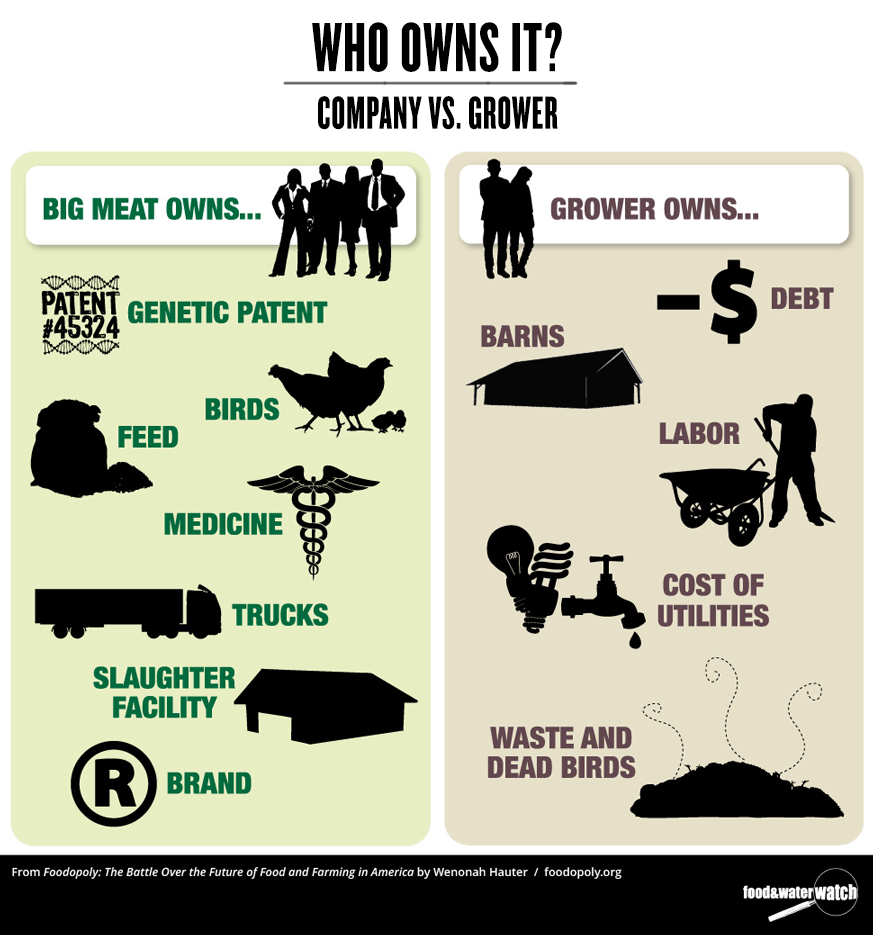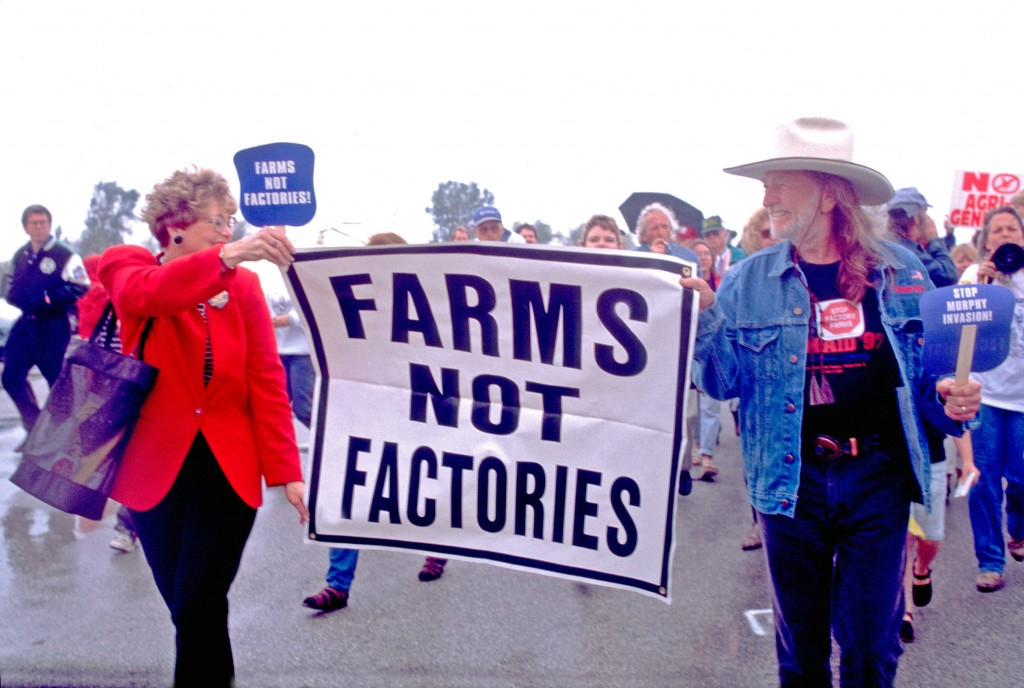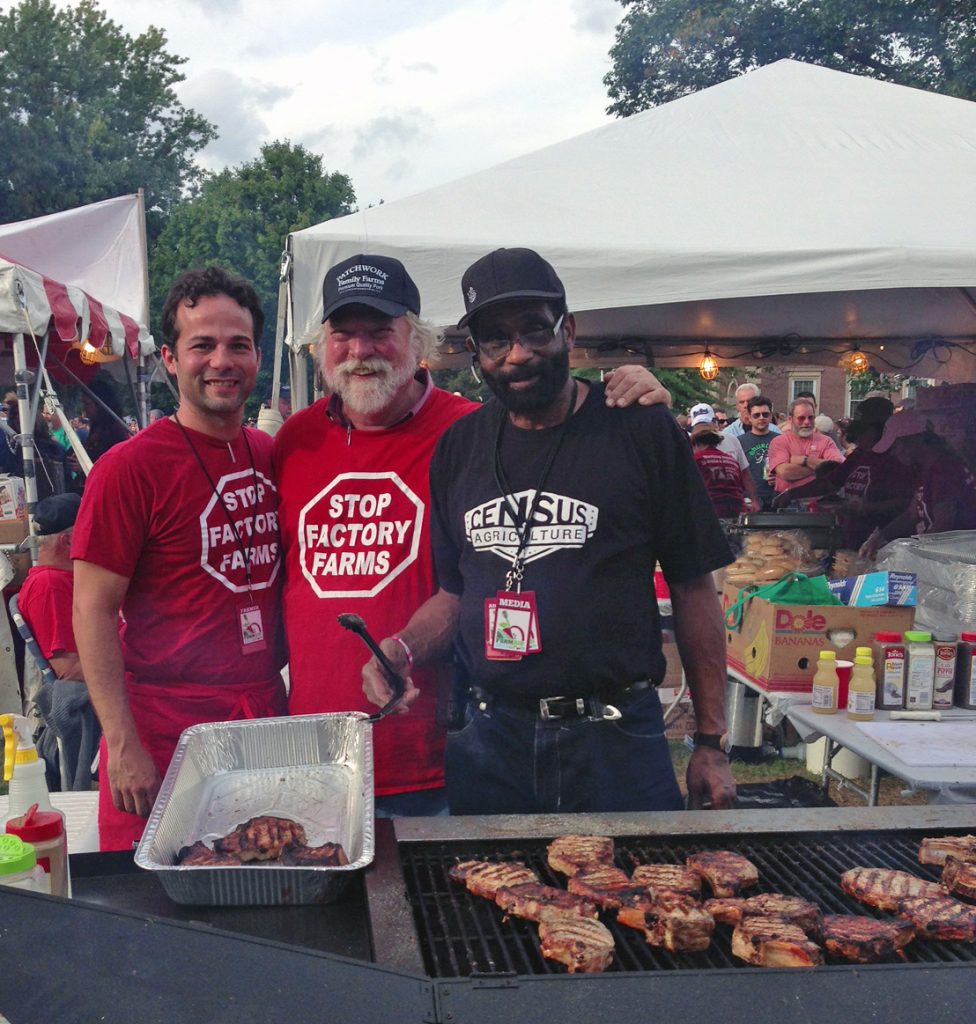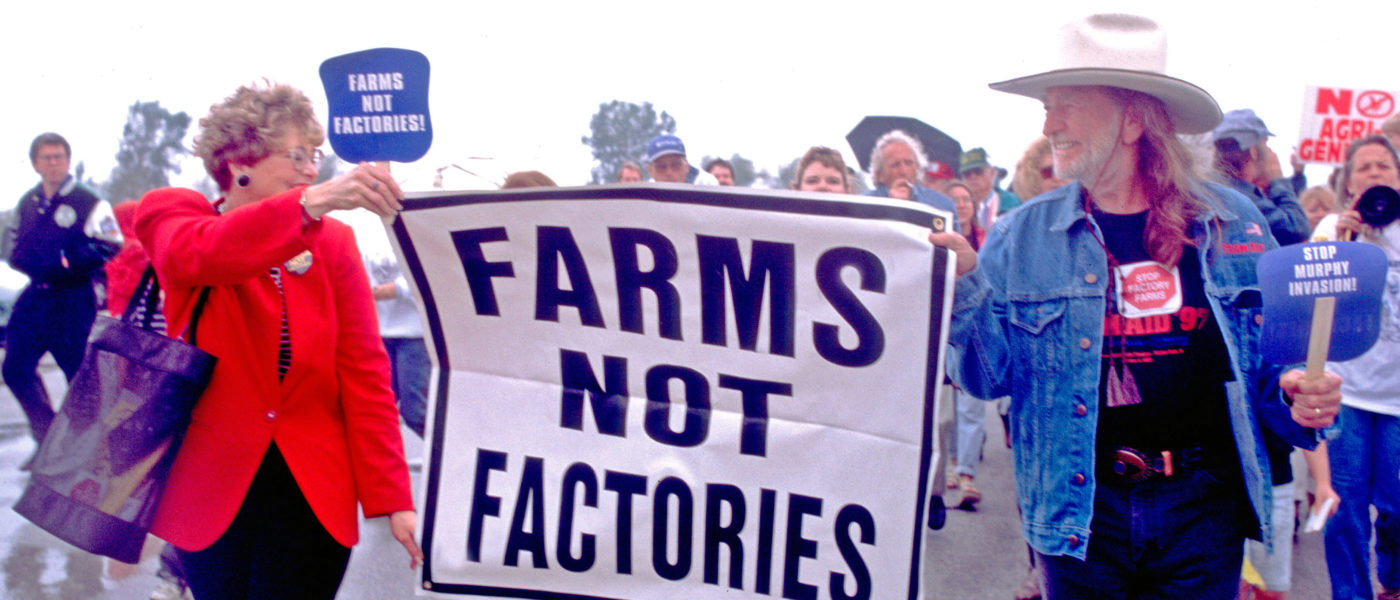What Are Factory Farms?
“Factory farms,” as they are commonly known, are industrial livestock operations that are more formally defined as concentrated animal feeding operations (CAFOs). CAFOs are large agricultural enterprises where animals are raised in confined settings (meaning inside buildings, not in open space) and are sustained on purchased or grown feed rather than by grazing. By definition, a CAFO is a significant source of surface water pollution. A large CAFO contains at least 1,000 cattle, 2,500 pigs, 30,000 broilers or 82,000 laying hens[1, 2].
Why are Factory Farms/CAFOs a Problem?
U.S. Department of Agriculture (USDA) data indicates a clear trajectory toward fewer and bigger farms that control a larger share of production across all livestock sectors in the United States. This trend has pushed tens of thousands of independent family farmer out of business. For example, between 1987 and 2007 the median hog farm size increased by 2,000 percent, while the number of farmers raising hogs fell by 69 percent[3]. Dairy herd size and egg production saw similar shifts to much larger operations from 2007 to 2017[4].

This loss of family farms hurts local economies and communities. Because CAFOs are often part of a vertically integrated supply chain in which a large (often multinational) corporation controls numerous stages of livestock production, transactions typically flow within the corporation and profits are siphoned off to its investors, rather than reinvested in the local economy. By contrast, independent farmers are likely to invest in their local communities to purchase inputs and services needed on their farms (from supporting the local feed store to the local bank), keeping these dollars circulating close to home.
While many people are aware of the impact of factory farms on animal health, their impact on human health–both of the farmers and the community around the facilities–is often overlooked and underestimated. Animal waste contains pathogens, as well as nitrogen, phosphorus, ammonia, and other pollutants that cause harmful algal blooms, threaten aquatic ecosystems and impair drinking water. This waste can also end up as particulate matter in the air, raising rates of respiratory disease in nearby communities. Additionally, CAFOs administer non-therapeutic doses of antibiotics in order to prevent disease and bolster animal growth; this reliance on antibiotics has contributed to the rise in antibiotic resistance and reduced the effectiveness of these drugs for humans[5].
The waste produced by CAFOs results in air and water contamination, soil degradation, nutrient runoff, elevated hormone and antibiotic levels in the environment and illnesses in surrounding communities. These impacts are a form of environmental racism that has been well-documented since the 1990s; CAFOs are disproportionately built in majority Black, brown, and poor communities, where the effects of these operations contribute to health and economic inequities[6].
The farmers who operate CAFOs don’t necessarily intend to harm communities and the environment; they are operating in a system that rewards economies of scale, regardless of the cost to human health, animal welfare and the environment. Many farmers are often hamstrung by contracts with large meat producers and are given no choice about raising livestock at a large scale; in order to stay in business they must get big or get out.
What Has Caused the Growth of Factory Farms/CAFOs in the U.S.?
The increasing corporate concentration of the agriculture sector has led to the rise of large-scale CAFOs, which has shifted American agriculture away from the diversified small-scale family farm model. Under this corporate-dominated system, farmers often function as a contract grower following the corporations’ strict protocols–removing the autonomy to make decisions on their own farm. Federal policies such as government crop insurance subsidies for animal feed crops, along with unfair business practices, particularly through contract arrangements, have largely contributed to this trend. And the growing distance between producer and consumer that results enables the industrialization and corporate concentration of our meat supply to proceed without much notice or protest from the general public.

What is Farm Aid Doing About CAFOs?
Fighting the growth of CAFOs is central to Farm Aid’s mission to build a vibrant family farm-centered system of agriculture. Since the 1990s, when farmers and farm groups first spoke up about the damage to rural areas caused by this emerging model of “factory farms in the hog industry” Farm Aid has supported a national effort to stop factory farms through the Campaign for Family Farms and the Environment (CFFE), a dynamic collaboration of regional farm groups. Farm Aid is also active in the Campaign for Contract Agriculture Reform (CCAR), a national alliance of organizations working to address corporate consolidation in the livestock sector.
Farm Aid works with CFFE and other partner organizations to advocate for policies that support the viability and profitability of small- and mid-sized farms. If you’ve been to a Farm Aid festival, you may have met some Missouri farmers and advocates who are part of Missouri Rural Crisis Center/Patchwork Family Farms, one of our longest partners in this work. They’re hard to miss in their bright red Stop Factory Farms t-shirts, and their family-farm-raised pork is always a crowd favorite at the Farm Aid festival!
Small and mid-sized farms stand in stark contrast to large, industrial-scale CAFOs as sustainable producers of livestock who take into account the impact of their operations on animal, human and community well-being. Farm Aid advocates for policy that incentivizes sustainable livestock practices, such as rotational grazing and alternative manure handling systems that do not include digesters, which have become a false climate solution that both justifies the expansion and growth of CAFOs and enriches the energy industry. Farm Aid also advocates for mandatory country of origin labeling for beef, which provides transparency to consumers so they can make informed choices about where their meat comes from.
Additionally, Farm Aid stands with rural, grassroots organizations fighting against the development of new CAFOs in their communities.

Patchwork Family Farms takes a moment to pose while serving concertgoers at Farm Aid 2016.
Whether we live in a rural community threatened by CAFOs or not, we all have a role to play to stop CAFOs. Farm Aid’s work to grow the Good Food Movement encourages eaters to choose local, sustainable and humanely raised foods, deepens relationships between producers and consumers, and advocates for policies that level the playing field for small and mid-sized producers to keep family farmers on the land and thriving.
Sources
- EPA. “Regulatory Definitions of Large CAFOs, Medium CAFOs, and Small CAFOs.” https://www.epa.gov/sites/default/files/2015-08/documents/sector_table.pdf
- USDA Economic Research Services. “The Transformation of U.S. Livestock Agriculture.” 2009. https://www.ers.usda.gov/webdocs/publications/44292/10992_eib43.pdf
- Lawrence, J. D., Grimes, Glenn 2007. Production and Marketing Characteristics of U.S. Pork Producers, 2006. Department of Economics Working Paper Series. Ames, Iowa, Iowa State University.
- James M. MacDonald. Tracking the Consolidation of U.S. Agriculture. Applied Economic Perspectives and Policy, 2020; DOI: 10.1002/aepp.13056
- Barrett JR. Airborne Bacteria in CAFOs: Transfer of Resistance from Animals to Humans. Environ Health Perspect. 2005 Feb;113(2):A116–7. PMCID: PMC1277892.
- Steve Wing, Gary Grant, Merle Green and Chris Steward. “Community based collaboration for environmental justice: south-east Halifaz environmental reawakening.” Environment and Urbanization, Vol. 8, No. 2, October 1996
Further Reading
- Read “Life Under Contract: Poultry Farming in Arkansas“
- Watch a documentary film, “Under Contract: Farmers and the Fine Print,” a brutally honest look at contract poultry



